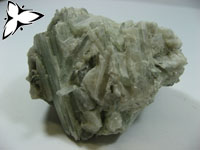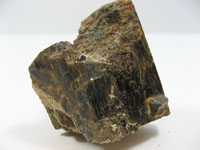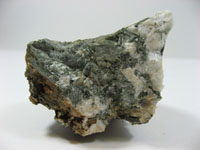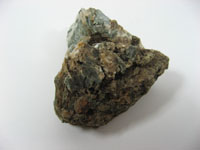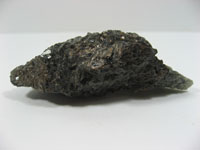![]()
Actinolite is an amphibole silicate mineral in the asbestos group. The name actinolite is derived from the Greek word ἀκτίς (aktis), meaning "beam" or "ray", because of the mineral's fibrous nature. This word is also the origin of the name of the chemical element actinium. Fibrous actinolite is one of the six recognized types of asbestos, the fibres being so small that they can enter the lungs and damage the alveoli. Actinolite asbestos was once mined along Jones Creek in Gundagai, Australia.
![]()
Within the metaphysical realm of minerals, actinolite brings the believer's body functions into harmony and balance. It can affect the colour vibration of other stones and enhances their overall effectiveness. It stabilizes the physical crystallization process (a process that anchors either a positive or a negative ‘now’ consciousness) and can restructure the believer's cells into a positive crystallization. Actinolite helps strengthen the processes of the believer's physical body, and allows it to accept what has taken place. It encourages their spirit to explore new directions, and gives awareness if the believer has strayed from their original goals. It promotes a feeling of self-worth and strength and encourages inner balance and patience. It helps instigate the balancing process of emotional and physical acceptance, and produces the openness and the well-being that allows the believer to be available and receptive to Divine energies.
Please note that MIROFOSS does not suggest in any way that minerals should be used in place of proper medical and psychological care. This information is provided here as a reference only.
![]() Certain types of actinolite are used as gemstones.
Certain types of actinolite are used as gemstones.
![]()
Actinolite is commonly found in metamorphic rocks, such as contact aureoles surrounding cooled intrusive igneous rocks. It also occurs as a product of metamorphism of magnesium-rich limestone.
![]()
Actinolite is an intermediate member in a solid-solution series between magnesium-rich tremolite, and iron-rich ferro-actinolite. Mg and Fe ions can be freely exchanged in the crystal structure. Like tremolite, asbestiform actinolite is regulated as asbestos. The old mineral name uralite is at times applied to an alteration product of primary pyroxene by a mixture composed largely of actinolite. The metamorphosed gabbro or diabase rock bodies, referred to as epidiorite, contain a considerable amount of this uralitic alteration.
Other than in the basic mineral form, actinolite can be found in one distinct variety:
![]()
| Cleavage | Perfect | |
| Colour(s) | Green, Green black, Gray green, Black | |
| Specific Gravity | 3.04 | |
| Diaphaneity | Translucent to Transparent | |
| Fracture | Splintery - Thin, elongated fractures produced by intersecting good cleavages or partings | |
| Mohs Hardness | 5.5 | |
| Luminescence | Non-fluorescent | |
| Luster | Vitreous | |
| Streak | White | |
| Habit(s) | Bladed to Fibrous to Radial | |
| Radioactivity | Non-radioactive | |
| Magnetism | Non-magnetic |
![]()
The following health hazards should be noted when handling actinolite:
 |
BIOHAZARD Actinolite can cause asbestosis, lung cancer, and both pleural and peritoneal mesothelioma. |
![]()
The following image shows the Elemental breakdown of the mineral actinolite along with the mineral crystal structure.
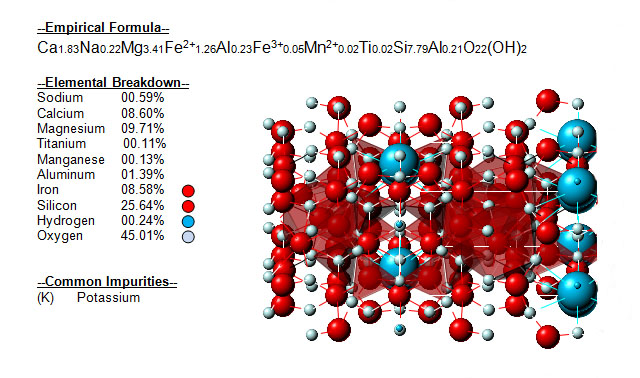
![]()
| Crystal System | Monoclinic | |
| Class | Prismatic | |
| Axial Ratios | a : b : c = 0.5436 : 1 : 0.2917 | |
| Twinning | simple or lamellar, common parallel | |
| Optical Data Type | Biaxial (-) | |
| Pleochroism (x) | Pale yellow | |
| Pleochroism (y) | Pale yellow, Green | |
| Pleochroism (z) | Pale green, Deep greenish blue |  |
| RL Values | nα = 1.613 - 1.646 nβ = 1.624 - 1.656 nγ = 1.636 - 1.666 | |
| 2V | Measured: 79° to 86°, Calculated: 78° to 82 | |
| Max Birefringence | δ = 0.023 (See colour chart at right) | |
| Surface Relief | Moderate | |
| Dispersion | r < v |
![]()
Actinolite can be referenced in certain current and historical texts under the following seven names:
The mineral actinolite can be translated into the following select languages:
| Arabic | الأكتينوليت | Bulgarian | Актинолит | Chinese (Sim) | 阳起石 |
| Croatian | aktinolit | Czech | Aktinolit | Danish | actinolit |
| Dutch | Actinoliet | Esperanto | Estonian | aktinoliidi | |
| Finnish | Aktinoliitti | French | Actinote | German | Aktinolith |
| Greek | Hebrew | אקטינוליט | Hungarian | Aktinolit | |
| Italian | Japanese | 緑閃石 | Korean | 악 티노 | |
| Low Saxon | Aktinolith | Lithuanian | aktinolitas | Norwegian | |
| Persian | اکتینولیت | Polish | Aktynolit | Portuguese | Actinolita |
| Romanian | actinolit | Russian | Актинолит | Slovak | Aktinolit |
| Spanish | Actinolita | Swedish | Aktinolit | Tagalog | |
| Turkish | aktinolitin | Ukrainian | Актиноліт | Vietnamese |
![]()
Actinolite can be found in many places around the world. The map below shows major documented concentrations of actinolite:

![]()
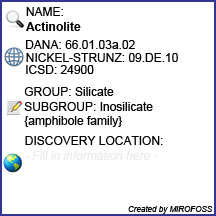 |
The MIROFOSS database offers free printable geological identification tags for personal and non-profit use. These tags can be used to properly identify mineral samples in your collection. -Click here- to download a full size jpeg image for a actinolite identification tag; which can be printed on paper or used with a plastic laser printer. |
 |
What's this? What can I do with it? |
![]()
| Crystallography | Hawthorne, F. C. and Oberti, R. (2006): On the classification of amphiboles. Canadian Mineralogist 44, 1-21. |
| History | Mineralogical Record: 29: 169-174. |
| History | Canadian Mineralogist (1983) 21: 173. |
| Geographical Data | Mindat.org. Retrieved on 2012-07-30 |
| Physical Identification | Webmineral.com. Retrieved on 2012-07-30 |
| June 25, 2014 | The last time this page was updated |
| ©2017 MIROFOSS™ Foundation | |
 |
|

